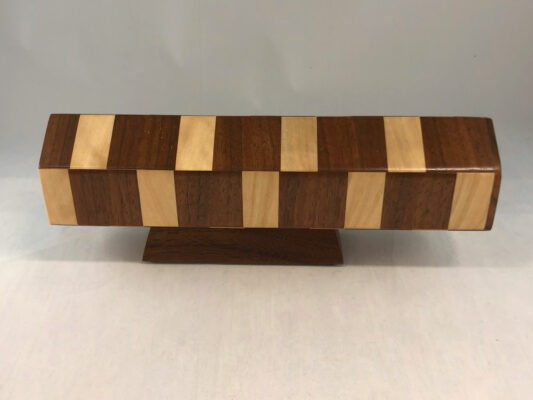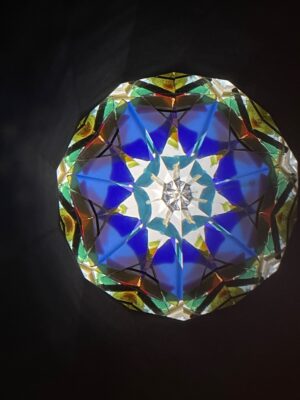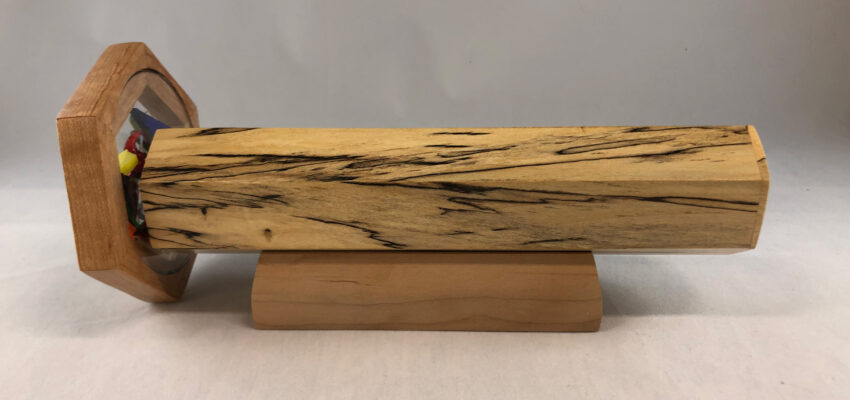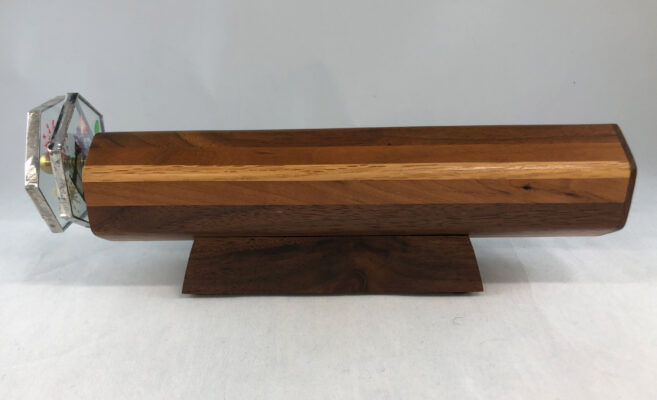This page is being updated as Artist register.
2023 Exhibiting Artist
I started out in the early 1980's as a mechanical engineer working to design and install modern sailing rigs on cargo ships. From there I worked at a place that designed and refined medical equipment. It was there that I discovered modern kaleidoscopes in a gallery near where I ate lunch. I thought to myself, "I could make these." Four months later I was laid off. This was in 1987 and it was time to go somewhere else, so I moved from Boston to Colorado. I have been making kaleidoscopes in one form or another ever since.
I started woodturning with my Dad in High School and am now retired and a fulltime wood turner. I spent my earning years as a business owner with my wife specializing commercial design and IT System Integration for the Army Virtual Training Centers Worldwide. I began making kaleidoscopes some 30 years ago after seeing Steven Gray demo at a woodturning EXPO in Provo, Utah. I joined the Brewster Society in 2018 to take classes (at the EXPO and in Jerome) and began to learn how to create a quality scope. I use dozens of variety of woods from exotic rosewoods like Cocobolo and African Blackwood to domestic figured Maple and Mesquite.
R Scott Cole has been designing innovative kaleidoscopes since 1983. His work has been exhibited in museums and galleries across the United States and has been featured on television in addition to numerous books, magazines, and newspapers. The primary force in his artistic development has been exploring how different materials can be utilized creatively in kaleidoscope design. Consistent with much of his life's work, he enjoys teaching and has conducted workshops in many locations, including Penland, John C Campbell Folk School, Thailand, as well as numerous Brewster Kaleidoscope Society Conventions and other locations across the country. His latest project is a 40-foot, interactive, walk-in silo kaleidoscope. His home and Laughing Eye Studios are in Brasstown, North Carolina
I'm a kaleidoscope-makin', motorcycle-ridin', furniture-buildin' grandpa (not necessarily in that order!
After many years of admiring and collecting kaleidoscopes, in 2017, I had the opportunity to take a week long class at John C. Campbell Folk School in the creation of kaleidoscopes. After a week working with Marc Tickle, I was totally committed to learning as much as I could about designing and making kaleidoscopes. I have been a wood carver for most of my life and wanted to use this skill, along with working in stained glass, to build unique works. Since then I have designed and made many original pieces. In June of 2019, I attended the Brewster Society International Kaleidoscope Convention in Scottsdale, AZ, to exhibit my scopes and unveil one of my hand carved. I exhibited again in 2022 at the Convention in St. Louis and the Foundry Art Center exhibit in St. Charles, MO.
I currently exhibit my kaleidoscopes at Reflections Gallery in Chattanooga, TN, and with the Association for Visual Arts in Chattanooga. In the past, Hunter Museum of Art has displayed pieces.
I currently exhibit my kaleidoscopes at Reflections Gallery in Chattanooga, TN, and with the Association for Visual Arts in Chattanooga. In the past, Hunter Museum of Art has displayed pieces.
Has been creating stained and fused glass kaleidoscopes since the 1980s. Commissions include Warner Brothers Studios and Sony Japan. Galleries throughout the US and Japan exhibit her work.
Charles Karadimos began working with stained glass in 1975 and made the transition exclusively to building glass kaleidoscopes in 1980. In the early days of the kaleidoscope renaissance, his main focus was concerned with creating crisp, vibrant, interior images and exploring and developing mirror systems with crystal clear optics that would produce rich, ever-changing patterns. And he has worked very hard towards mastering the development of the perfect kaleidoscope image. For without the image, it just isn't a kaleidoscope. Charles has designed and built thousands of kaleidoscopes, making each part of every scope by hand. There are no machined parts. Every piece -- down to the smallest shard of glass in the object chamber -- is hand worked and individually selected. All of his scopes feature a multidimensional slumped glass exterior, very nice to hold or display. Every piece is an original, signed, and numbered work of art. Charles' work is exhibited in many galleries, museums and private collections throughout the world. His work is featured in many books and publications and he is the recipient of numerous awards, including the Brewster Award for Creative Ingenuity. From November 2003 until January 2013 he served as one of the Directors of the Brewster Kaleidoscope Society, the international organization of kaleidoscope enthusiasts.
Peggy and Steve began their journey in glass in the late 1970's, executing traditional stained glass designs both leaded and the Tiffany technique, and began fusing glass in the early 1980's. A meeting with kaleidoscope artist Steven Gray changed their trajectory into making kaleidoscopes and they began creating fine handcrafted kaleidoscopes in 1986. They have become known for their classic 2-mirror imagery, and the highest quality optical reflections defined by the incredible display of miniature glass sculptures found in the object chambers. Each kaleidoscope is a collaboration of both of them, Steve's fusing skills result in clean, crisp definition of design often requiring multiple firing and annealing, and his optics using front-surface mirror create images of the highest standard. Peggy's flame-sculpted glass pieces floating in the oil-filled object chambers are among the most beautiful to be viewed through a kaleidoscope. Their work has been included in many exhibits: Strathmore Hall Art Center in Rockville, Maryland; the National Quilt Museum Kaleidoscope Exhibit in Paducah, Kentucky; Milwaukee Art Museum in Milwaukee, Wisconsin; the Museum of Northern Arizona in Flagstaff, Arizona; American Folk Art Museum in New York, NY, & Akron Art Museum, Akron, Ohio as part of the Paula Nadelstern Kaleidoscope Quilt Exhibit; a permanent kaleidoscope exhibit at the Teruko Tsuji Memorial Art Museum in Sendei, Japan; the Kaleidoscope Museum of Kyoto; many of their pieces are in the Cozy Baker Collection; and they have exhibited at Fine Arts and Crafts Shows including the prestigious Smithsonian Craft Show. They have been recognized with numerous awards given at Brewster Kaleidoscope events and glass competitions.
Sheryl has been making kaleidoscopes since 1980. She has been a stained glass artist since the early 1970's and has combined the 2 art forms over the years to create many beautiful kaleidoscopes! Known in the kaleidoscope world for making turning wheel kaleidoscopes early on, she now likes to experiment and incorporate different mediums into her kaleidoscopes such as copper metal working, and enameling, and torch work. Working with color is her life's work and the freedom to experiment and 'play' with new things is her inspiration.
I was raised in a kaleidoscope. My dad's barber shop was lined with mirrors and I could never count how many times I could see myself. I accidentally took a kaleidoscope class and immediately I was hooked; so many types of scopes, such beautiful images, infinite variety. It can't get better than this.
Jim has been a stained glass artist for over 25 years, focusing primarily on designing and creating one of a kind windows. He started making stained glass and stone kaleidoscopes in 2015 in earnest. Using semi-precious stone slabs allows him to create one of a kind hand-held and parlor scopes. The kaleidoscopes that Jim makes are available on his Facebook page , through his Etsy store: nebraskascopesstudio, or locally in the Midwest at Custom Gems, 8487 Frederick St. Omaha, Ne and the Passageway Gallery in the Old Market area of Omaha.
His work can be seen and purchased via his Facebook page or in his Etsy store: nebraskascopesstudio.
https://www.etsy.com/shop/NebraskaScopesStudio
His work can be seen and purchased via his Facebook page or in his Etsy store: nebraskascopesstudio.
https://www.etsy.com/shop/NebraskaScopesStudio
We began making kaleidoscopes in 1994. Our first product was a kaleidoscope kit that we marketed to Junior Achievement Companies to be used as a product the kids manufactured and then sold. We were both JA advisors and though the kit was a great project for the kids, it didn’t provide us with much of a challenge or creative outlet. We began making different kinds of scopes; creating different body styles and discovering different ways to create the images. We learned how to put together boards to create inlay to use in some of our scope bodies. As we learned more about kaleidoscopes, we became involved in the Brewster Kaleidoscope Society, a group of kaleidoscope artists, collectors, and shop owners. This gave us the opportunity to meet many of the people in the kaleidoscope community where we formed connections that both helped us to grow as artists, and to sell our scopes in shops around the country.
I grew up in the south of England where I studied mathematics, psychology and computer programming before discovering the beauty of art glass and kaleidoscopes. I now live in Asheville, North Carolina with my wife and our two sons. I design and make my pieces in my home studio.
Bob Tupa's interest in kaleidoscopes started as a child when he was searching through his grandmother's attic and found the kaleidoscope that was made as a shop project by his father in high school. His father was an automotive research mechanical engineer and one of his father’s hobbies was woodworking. So those skills were passed down. One day at a local hardware store there were several boxes of broken window glass. The business allowed him to have several boxes for free and so there was sufficient material to learn how to cut glass. He progressed to incorporate colored glass into terrariums and lampshades. After starting in medical practice, he met a patient who owned his own stained-glass business. This gentleman was an artist trained in Italy to do Cathedral Windows as well as many other applications. Over the years that association as well as others have allowed for expanded skills in manipulating glass. This includes working with oxy-propane torche lampwork as well as kiln work. Over the years there has been a strong interest in art and design. This was fostered in the family. His sister was a graphic artist who trained at and taught at the Cleveland Institute of Art. His wife pursued a major in art at Ursuline College. He then became more familiar with jewelry, metalwork, enameling, and ceramics,. Attention to the visual was further enhanced with an additional hobby of photography. So the interest in these different fields started to naturally come together making kaleidoscopes. He first started making kaleidoscopes 10 to 15 years ago but since retirement has been able to concentrate more attention to materials and methods. He joined the Brewster society approximately 4 years ago. Courses at the annual meetings have helped solve some technical issues with object cells etc. Plans are to continue to explore blending natural materials and particularly figured woods into scope design. Other aspects to explore are different mirror systems, lighting, and manipulating image design where there is no mirror.

























































































































